A Late Fall Visit to
Mystic Seaport Museum
by Peter Vanderwaart pvanderw@optonline.net |
| On November 2, I paid a visit to the Mystic Seaport Museum in Mystic,
Connecticut. I have been a member of the Seaport for many years, and I try to get back at
least once a year to refresh my soul. The Museum has an enormous collection of boats
ranging from small craft to major vessels, and I took as many pictures as I could. The big ships get the most attention, of course, especially from
first-timers. Let's get them out of the way first.
(Click on the pictures for a larger image in a viewing window. If
necessary, drag the new window so it is entirely visible on the screen. To continue, click
outside the border of the viewing window to bring this page back on top.) |
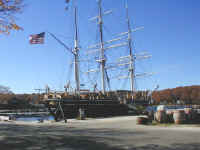 The whaling ship Morgan
is the Seaport's signature vessel. The whaling ship Morgan
is the Seaport's signature vessel. |
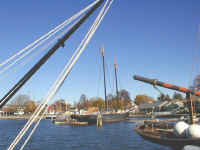 The L.A.
Dunton is a Glouchester fishing schooner. Her booms and some other rigging has
been removed. More on that later. The L.A.
Dunton is a Glouchester fishing schooner. Her booms and some other rigging has
been removed. More on that later. |
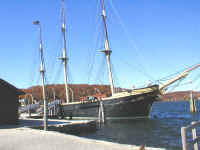 The Joseph
Conrad was built as a sailing school vessel. Alan Villiers sailed her around
the world. The Joseph
Conrad was built as a sailing school vessel. Alan Villiers sailed her around
the world. |
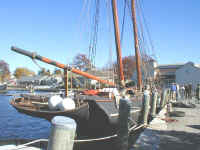 This is the Amistad,
which was built at the Seaport's shipyard and launched last spring. She belongs to Amistad America As a
reproduction of a cargo schooner, she does not have the brightwork that we associate with
yachts. This is the Amistad,
which was built at the Seaport's shipyard and launched last spring. She belongs to Amistad America As a
reproduction of a cargo schooner, she does not have the brightwork that we associate with
yachts. |
Before we go on with the boats,
let's look at some land-side points of interest. |
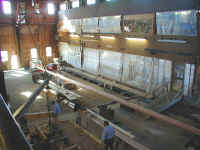 The facility that the
Seaport uses to maintain and repair its boats is called the DuPont Preservation Shipyard.
This is the interior of their big boatbuilding shed. The Amistad was
built here. The facility that the
Seaport uses to maintain and repair its boats is called the DuPont Preservation Shipyard.
This is the interior of their big boatbuilding shed. The Amistad was
built here.I infer that the long spar that occupies
the middle of the shed is a new boom for the L.A. Dunton. I wonder what
it was like to jibe in a strong wind! It may have been shaped on the spar lathe which is
visible as a grey platform along the far wall. Imagine being able to use a lathe to turn
such a long spar.
Beyond the plastic are galleries holding all the usual
boatbuilding tools. |
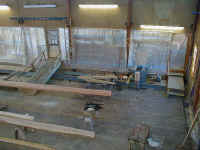 This shot shows the
other end of a) the spar and b) the spar lathe. In between, you can see the parts for the
massive boom jaws. This shot shows the
other end of a) the spar and b) the spar lathe. In between, you can see the parts for the
massive boom jaws. |
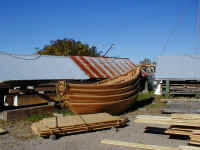 Part of the lore of
the Grand Banks fishing dories is that they were designed to be stacked on the deck of the
big schooner. Here is a stack of the L.A. Dunton's dories being prepared
to spend the winter on land. They are surrounded by a small part of the Seaport's
inventory of boatbuilding woods. Part of the lore of
the Grand Banks fishing dories is that they were designed to be stacked on the deck of the
big schooner. Here is a stack of the L.A. Dunton's dories being prepared
to spend the winter on land. They are surrounded by a small part of the Seaport's
inventory of boatbuilding woods. |
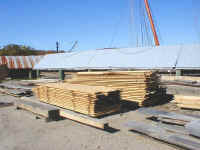 This is a picture of
technical interest to boatbuilders only. It is a textbook example of how to 'stack and
sticker' your wood so it will air dry properly. I didn't try identify the species of wood. This is a picture of
technical interest to boatbuilders only. It is a textbook example of how to 'stack and
sticker' your wood so it will air dry properly. I didn't try identify the species of wood. |
Now a look at some medium-sized
vessels, starting with a pair of power craft. |
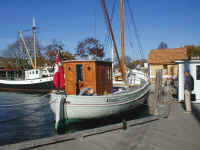 Gerda was
built as a Danish lighthouse tender. She was restored to new condition as testimony to her
service in WWII carrying Danish Jews to safety in Sweden. She is flying the Danish colors.
Her hull probably has a more direct link to Colin Archer than most of the stocky
double-ended sailing yachts that are sold with his name attached. Gerda was
built as a Danish lighthouse tender. She was restored to new condition as testimony to her
service in WWII carrying Danish Jews to safety in Sweden. She is flying the Danish colors.
Her hull probably has a more direct link to Colin Archer than most of the stocky
double-ended sailing yachts that are sold with his name attached. Gerda doesn't fit into the "New England and
the Sea" theme of the Seaport. She was taken in when plans for a more suitable home
fell through. |
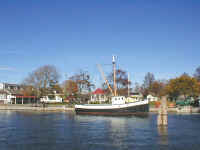 Moored near Gerda
is the Eastern Dragger Florence, one of the museum's newer acquisitions.
Her inclusion reminds us that all of the wonderful sailing craft were once as common and
unremarkable as this little 20th century fishing vessel. Moored near Gerda
is the Eastern Dragger Florence, one of the museum's newer acquisitions.
Her inclusion reminds us that all of the wonderful sailing craft were once as common and
unremarkable as this little 20th century fishing vessel. |
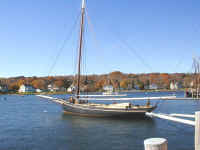 The Emma C.
Berry is described as a Noank Well-Smack. (Noank is a small town a short distance
from Mystic, at the mouth of the Mystic River.) She was built in 1866 as a fisherman and
fish carrier. Of all the boats in the Seaport's collection, she is the closest to the
traditional New England Sloop or Gloucester sloop-boat. Boats of this shape were used to
carry cargo as well as for fishing. The Emma C.
Berry is described as a Noank Well-Smack. (Noank is a small town a short distance
from Mystic, at the mouth of the Mystic River.) She was built in 1866 as a fisherman and
fish carrier. Of all the boats in the Seaport's collection, she is the closest to the
traditional New England Sloop or Gloucester sloop-boat. Boats of this shape were used to
carry cargo as well as for fishing.Charles
Wittholtz, the late designer of Cape Cod Catboats, used the term 'Noank Sloop' for a
catboat hull with a gaff sloop rig. As you can see here, the true Noank Sloop is a little
different. |
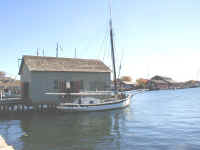 Nellie
is centerboard sloop built in 1891 to dredge oysters. She is the Long Island Sound
equivalent of the better-known Chesapeake Bay Skipjack. Square sterns were more common
than round sterns like Nellie's. Nellie
is centerboard sloop built in 1891 to dredge oysters. She is the Long Island Sound
equivalent of the better-known Chesapeake Bay Skipjack. Square sterns were more common
than round sterns like Nellie's. All
19th century fishing craft were worked by having the nets, dredges or traps lifted aboard
and unloaded on deck by manual labor. As a result, the boats are low-sided with broad
decks and small houses, characteristics that make it challenging to adapt these boats as
yachts. |
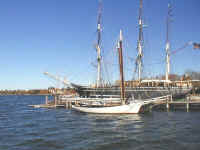 The Seaport
identifies the Estella A. as a Maine Sloop, but acknowleges that today
she would probably be called a Friendship Sloop. In fact, she was built in Bremen, Maine.
I think she is a handsome vessel, but does not have the prettiness associated with the
boats built at Friendship, Maine by Wilbur Morse. If you are interested in Friendship
sloops, you should know about the Friendship Sloop
Society The Seaport
identifies the Estella A. as a Maine Sloop, but acknowleges that today
she would probably be called a Friendship Sloop. In fact, she was built in Bremen, Maine.
I think she is a handsome vessel, but does not have the prettiness associated with the
boats built at Friendship, Maine by Wilbur Morse. If you are interested in Friendship
sloops, you should know about the Friendship Sloop
SocietyThese boats are surely one of
the most beautiful tools ever created for a man to use to earn his living. |
Moving down another notch in
stature, we have two sizeable open boats. |
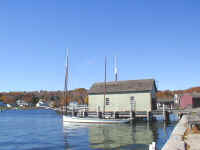 This 35' boat is a
New Haven Oyster Tonging Sharpie. In use, it would be moored over the oyster bed by stakes
driven into the bottom. Two men using tongs with 20' handles would pick up oysters from
the sea bottom and dump them in the boat. Fully loaded, she would hold 150-175 bushels of
oysters. This 35' boat is a
New Haven Oyster Tonging Sharpie. In use, it would be moored over the oyster bed by stakes
driven into the bottom. Two men using tongs with 20' handles would pick up oysters from
the sea bottom and dump them in the boat. Fully loaded, she would hold 150-175 bushels of
oysters.
Additional pictures show bow
and stern
detail of the sharpie. |
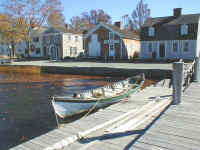 This is a whale boat.
When a whale was sighted (Thar she blows!) six men would row away from the whaling ship in
a boat like this to kill the whale. This boat is set up for the Seaport's demonstrations
with a tub of line. This is a whale boat.
When a whale was sighted (Thar she blows!) six men would row away from the whaling ship in
a boat like this to kill the whale. This boat is set up for the Seaport's demonstrations
with a tub of line.The whaleboat's spars and oars
are lying on the dock in the foreground. In the background, you can see several of the
buildings that comprise the Seaport's reconstruction of a New England seaside town. |
We have finally gotten to the
small boats. Unfortunately, many of them were already laid up for the winter, but there
were still several interesting ones to see. |
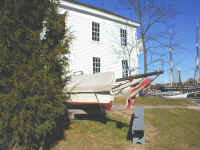 Even under her winter
cover, Grebe is instantly recognizable as a Chesapeake Bay boat by her
hard chine construction, thick forefoot, and long bowsprit. The massive keel and stem form
a battering ram that she uses to punch her way through waves. Even under her winter
cover, Grebe is instantly recognizable as a Chesapeake Bay boat by her
hard chine construction, thick forefoot, and long bowsprit. The massive keel and stem form
a battering ram that she uses to punch her way through waves.Although the skipjack hull form gave rise to hundreds of different designs for
v-bottom, plywood boats, the quick twist of deadrise near the bow can not be duplicated in
a boat built of panel material. Even in boats with the traditional cross-planked bottom
(like Grebe), this area of the forefoot was sometimes carved out of a
hunk of timber. For more information about Chesapeake Bay Boats, check out this link: Chesapeake Bay Marine Museum. |
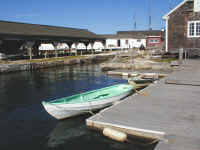 This dory skiff is
one of the small boats that the Seaport makes available to visitors during the summer
season. I'm not sure of the origin. My first guess was George Chaisson, and my second, on
comparison with some pictures, was William Chamberlain. In either case, it is a refinement
of the Swampscott dory type. This particular hull is probably a Seaport reproduction. This dory skiff is
one of the small boats that the Seaport makes available to visitors during the summer
season. I'm not sure of the origin. My first guess was George Chaisson, and my second, on
comparison with some pictures, was William Chamberlain. In either case, it is a refinement
of the Swampscott dory type. This particular hull is probably a Seaport reproduction. |
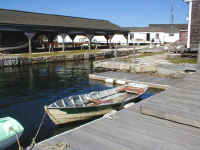 This skiff is named
the Waldo Howland, so I take it to be the 18 1/2 foot skiff designed by
Pete Culler for the gentleman of that name. It is an enlargement of Culler's famous Good
Little Skiff. Capt. Pete's unique powderhorn sheer is especially apparent in this
photograph. This skiff is named
the Waldo Howland, so I take it to be the 18 1/2 foot skiff designed by
Pete Culler for the gentleman of that name. It is an enlargement of Culler's famous Good
Little Skiff. Capt. Pete's unique powderhorn sheer is especially apparent in this
photograph. |
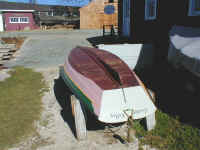 The name on the
transom of this skiff, George Kelley, marks her as another Pete Culler
boat. I believe she is a Good Little Skiff. The name on the
transom of this skiff, George Kelley, marks her as another Pete Culler
boat. I believe she is a Good Little Skiff. Her
bottom is cross-planked. Culler learned boatbuilding in a Chesapeake yard and his designs
reflect many Chesapeake practices, even though he lived and worked in New England in his
later life as a designer.
The late Mr. Kelley was a friend of Culler's and handled
the sale of his plans after his death. The plans are now in the collection of the Seaport,
and are available for purchase. |
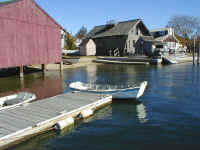 There were a couple of
these ruggedly built prams. They look like Culler boats, possibly the 10' Concordia Yard
Butthead design. There were a couple of
these ruggedly built prams. They look like Culler boats, possibly the 10' Concordia Yard
Butthead design. |
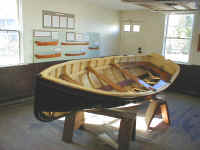 The last boat is Captain
Hook, a Whitehall pulling boat about 10' long. This little craft is 91 years old,
and she was in use until recently. She is on display next to the Small Boat Shop where she
was handy for reference as the staff recently built a reproduction. The last boat is Captain
Hook, a Whitehall pulling boat about 10' long. This little craft is 91 years old,
and she was in use until recently. She is on display next to the Small Boat Shop where she
was handy for reference as the staff recently built a reproduction. |
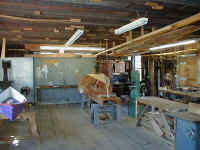 This is the Small Boat
Shop, possibly the most famous boatshop in the world, but that is mostly because no
boatshop is accorded very much fame. I suspect they keep it looking a little scruffy and
unpolished because that is how boatshops have always looked. This is the Small Boat
Shop, possibly the most famous boatshop in the world, but that is mostly because no
boatshop is accorded very much fame. I suspect they keep it looking a little scruffy and
unpolished because that is how boatshops have always looked.Points of interest: blocks of wood on the ceiling for miscellaneous
props and supports, blue table saw (right front), pale green bandsaw (right rear), work
tables and sawhorses. The partially constructed boat on molds at the back is a Chaisson
dory skiff. She has been frozen in the same state of arrested development for 12 years,
and is now more of an exhibit than a project. The object that looks like a small box
against the back wall on the left is the steam box, and next to it you can see part of the
cast iron stove that takes the chill off on cold winter days. A
flat-bottomed canoe painted a very untraditional purple color rests on sawhorses at left. |
| As part of the curatorial process, the Seaport prepares plans
on all the boats in the collection. Most are for sale at nominal prices. For some boats,
there is an additional fee if you wish to build a boat. Check with the Ships Plans office
at 860-572-5360. A good source of information
about them is a new book, Boat Plans at Mystic Seaport by Anne and Manyard Bray, available
in bookstores or from the Seaport Store (see link below). |
| The Mystic
Seaport Museum has much more of interest than the vessels shown in these
snapshots. If you are interested, follow the link, and take the mini-tour. There are many
more boats, plus a reconstruction of a 19th coastal village, exhibit halls with ship
models, scrimshaw, marine art, et cetera, et cetera. In the over-used phrase, it's worth a
trip from anywhere. |
Those are the best of my
pictures from the visit to Mystic Seaport Museum. I hope you enjoyed them. |